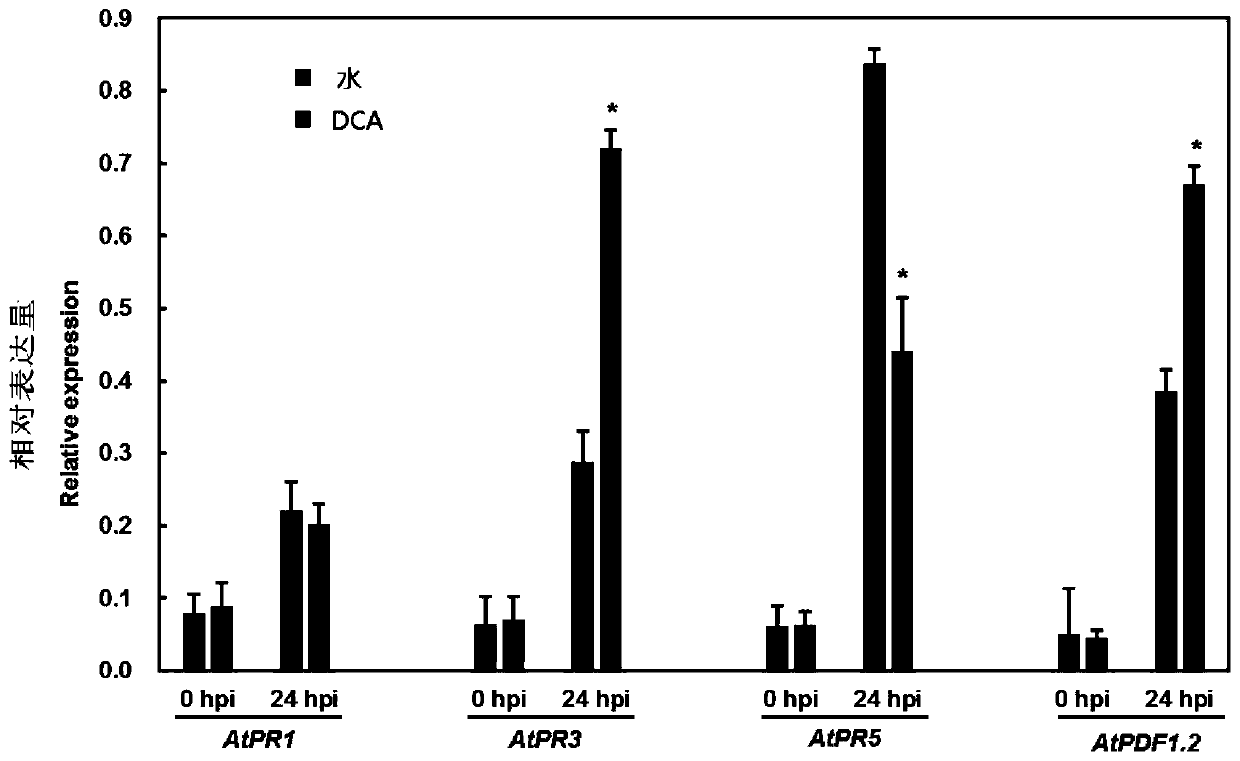Application of 3,5-dichloroanthranilic acid in induction of resistance of arabidopsis thaliana to gray mold and method of 3,5-dichloroanthranilic acid
An anthranilic acid, Arabidopsis technology, applied in 3. The compound is in the field of plant resistance induction, which can solve the problems of high cost of Botrytis cinerea, poor water solubility of the inducer, and environmental pollution, so as to achieve no secondary pollution and water solubility. The effect of good sex and low dosage
- Summary
- Abstract
- Description
- Claims
- Application Information
AI Technical Summary
Problems solved by technology
Method used
Image
Examples
Embodiment 1
[0037] Embodiment one: the cultivation of Arabidopsis plant
[0038] The seeds of wild-type Arabidopsis (Col-0) were suspended in 0.1% agarose solution, vernalized at 4°C for 2-4 days at low temperature, and sown in mixed nutrient soil (vermiculite: plant ash: perlite = 6 :2:1), apply fertilizer, dilute the fertilizer and water according to the mass volume ratio l:1000, and cover with film for 2-3 days to facilitate the emergence of seedlings. The culture temperature is maintained at 22-24 °C, the relative humidity is 80%, and the light intensity is about 85 μmol·s -1 m -2 , the light time is 16 hours. Other moisture, insect pests and cultivation management are as usual. 4-week-old Arabidopsis plants were used for the experimental treatments.
Embodiment 2
[0039] Embodiment two: the processing of 3,5-dichloroanthranilic acid
[0040] Prepare 10 μM 3,5-dichloroanthranilic acid aqueous solution. The roots of Arabidopsis plants were treated with 10 μM 3,5-dichloroanthranilic acid aqueous solution. The Arabidopsis plants were irrigated with the same volume of water as the control group, and two days later, Botrytis cinerea was inoculated.
Embodiment 3
[0041] Embodiment three: the Arabidopsis thaliana obtained by the processing of embodiment two is inoculated with Botrytis cinerea
[0042] Use 2×V8 solid medium (36% V8 fruit juice, 0.2% CaCO 3 , 2% agar) to cultivate Botrytis cinerea at a temperature of 20-25°C. After the dish is full of spores, put the mycelium block into the resuspension solution (4% maltose, 1% tryptone) and vigorously vortex to release the spores, filter the spores with gauze, and adjust the spore concentration with a hemocytometer 2×10 5Spores / mL. When inoculating, spray the spore suspension evenly on the inoculated seedlings until most of the leaves are covered with fine mist droplets. The inoculated seedlings were placed at 24°C, the photoperiod was 12 hours light / 12 hours dark, and the light intensity was 200 μE·m -2 S -1 , Observe the incidence after 4 days of highly moisturizing film. The same volume of resuspension was sprayed on Arabidopsis control plants as a control (MOCK).
[0043] as a...
PUM
 Login to View More
Login to View More Abstract
Description
Claims
Application Information
 Login to View More
Login to View More - R&D
- Intellectual Property
- Life Sciences
- Materials
- Tech Scout
- Unparalleled Data Quality
- Higher Quality Content
- 60% Fewer Hallucinations
Browse by: Latest US Patents, China's latest patents, Technical Efficacy Thesaurus, Application Domain, Technology Topic, Popular Technical Reports.
© 2025 PatSnap. All rights reserved.Legal|Privacy policy|Modern Slavery Act Transparency Statement|Sitemap|About US| Contact US: help@patsnap.com



